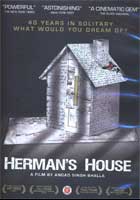
Herman’s House 2012
Distributed by First Run Features, 630 Ninth Avenue, Suite 1213, New York, NY 10036; 212-243-0600
Produced by Ed Barreveld and Loring McAlpin
Directed by Angad Singh Bhalla
DVD , color, 81 min.
Jr. High - General Adult
Art, Architecture, Criminal Justice, Design, History, Human Rights, Political Activism, Political Science, Sociology
Date Entered: 02/03/2014
Reviewed by Linda Kelly Alkana, Department of History, California State University Long BeachHerman Wallace, who died in 2013, was a former Black Panther Party member and a convicted murderer who spent over 40 years in prison, many years of which were in solitary confinement. Jackie Sumell is a younger multidisciplinary artist and political activist, who was drawn to reveal what she saw as the injustice of Wallace’s incarceration and the inhumanity of solitary confinement.
In Herman’s House, director, Angad Bhalla reveals the experiences of these two unlikely friends in a collage of a documentary that investigates many topics, including: Sumell’s artist creation, an architectural reconstruction of Wallace’s cell; Sumell’s plans for a community center for children based on Wallace’s dreams and designs, ironically reflecting the confinement he knew rather than the freedom he envisaged; telephone conversations between Sumell and Wallace from his cell (well-done with subtitles to compensate for poor quality and interference with prison announcements); an examination of Wallace’s life through interviews with those who knew him; an exploration of Sumell’s path to activism with images of her homey, but unhappy, family home in New York, which contrasts with images of the streets of New Orleans where she and Wallace envision the children’s center; and, with reference to the title of the film and the collaboration that produced it, coverage of the successful art gallery opening of the installation of Herman’s House.
The production quality of this unusual film is good, and the visuals are appropriate. Ultimately this is a film about the difficulties and rewards of making art, as well as the difficulties and rewards of political activism, situated in the context of Herman Wallace’s confinement where he can only dream about both.